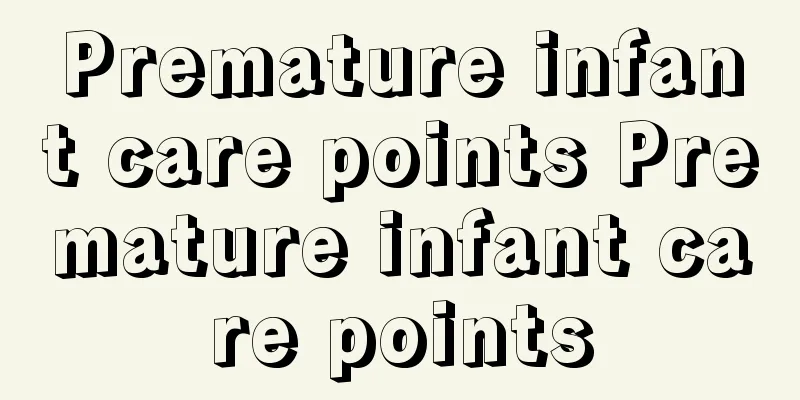What is the matter with the black hair on the newborn's ears? Pay attention to two situations

|
The ears are important organs and need our good protection. So, what is the matter with the black hair on the ears of newborns? What is the cause of black hair on the newborn's ears?1. Lanugo The black hair on the ears of newborns is mostly lanugo, which usually forms in the third trimester of pregnancy and is present in most full-term babies at birth. Lanugo usually appears on specific parts of the baby's body, including the back, shoulders, ears, and forehead. Lanugo usually falls off in the first week after the baby is born, but it may not fall off until a few months later. Notice: Never be smart and use a razor to shave your baby's hair, so as not to hurt the baby's delicate skin and hair follicles, because the hair will fall out automatically over time. 2. External auditory canal hirsutism If the black hair on the baby's ears is very long and thick, and has not receded after 6 months, it is very likely that it is external auditory canal hypertrichosis. The pathogenic gene of this type of genetic disease is located on the Y chromosome, and there is no corresponding gene on the X chromosome, so these genes can only be passed on with the Y chromosome, from father to son, son to grandson, and so on. Therefore, it is called "all male inheritance." Tips: The hair in the external auditory canal will become more obvious as you age. If you think it is unsightly, you can buy an electric nose hair trimmer to cut it off. Most nose hair trimmers have this function. How to take care of your baby's earsFirst step: ear cleaning The outer surface of the ear is in direct contact with the external environment, and frequent spitting up and sweating may cause dirt to stick to the ear and form lumps. Therefore, parents should pay as much attention to washing the ears as they do to washing the face. Cleaning method: First rub the baby bath gel into bubbles on your hands, then use your fingers to gently rub the back of the ears and the auricle, massage gently, and finally wipe clean with wrung-out gauze. At the entrance of the ear, you can use a cotton swab dipped in baby oil to gently wipe it. Be careful not to go too deep to prevent the baby's head from moving suddenly and injuring the ear canal mucosa. Step 2: Be gentle with earwax Earwax is different from eye mucus. It has certain physiological functions. When it encounters dry air, it will become thin flakes or sticky oily, blocking the invasion of dust, water and small flies. At the same time, it can buffer noise and inhibit the growth and reproduction of bacteria. It is the protector of the eardrum! Don't be a mysophobic parent. Earwax can fall off and be discharged by itself through actions such as chewing, opening the mouth or yawning, as well as with the help of movements of the jaw and other joints. Never dig it out without permission. Step 3: Beware of environmental noise The harm of noise to the ears should not be underestimated, especially high-decibel noise. In addition, babies cannot actively avoid noise like adults, so they will be more harmed. Do not take your baby to KTV, bars and other noisy places, and do not use headphones for your baby. Not only is the decibel high, but it will also bring strong internal and external pressure to the ears, which is not conducive to ear development. Parents should help their babies recognize high-decibel noises in time and teach them the correct ways to avoid them, such as opening their mouths, turning their ears towards a quiet direction and running away, or temporarily covering the opening of the external auditory canal with their fingers. Step 4: Pay attention to your physiological posture When feeding a baby, the baby's head should be kept slightly elevated, and this position should be maintained for a while after feeding. Do not lay the baby flat immediately to avoid spitting up or spilling milk, and milk flowing into the ear canal. At the same time, pay attention to the sleeping position. When the baby lies on his side, the ear should be flattened to avoid twisting and pressure on the auricle. At the same time, do not tilt your head when bathing or swimming to avoid water entering the ear canal. If water gets into the ear, use a cotton swab or cotton ball to remove the dirty water in the ear in time. Do newborn babies need to have their ears pulled?There is no need to pull the ears of a newborn baby. The older generation will say that after a baby is born, the baby's ears need to be pulled so that they don't grow close to the scalp and will look good. In fact, this is nonsense. Because the baby's skin is delicate and the auricle cartilage is fragile, if you pull the baby's ears without authorization, it is easy to cause damage to the ear cartilage and cause local inflammation. Therefore, never pull the ears of a newborn. What to do if water gets into the newborn's ears1. First, use a dry towel or gauze to wipe all the water off the baby's ear, then gently put a clean cotton ball into the baby's ear, but don't push the cotton ball in hard. 2. Tilt the baby's head towards the side where it enters the water, and let the cotton ball automatically absorb the water. Take it out when the cotton ball becomes wet. PS: If there is no improvement after emergency treatment and the baby still feels uncomfortable, parents should take the baby to the hospital and seek professional treatment from a doctor. |
<<: How long does it take for a baby's hearing to fully develop? 12 months or more
>>: How to effectively treat eczema? Treating both internal and external factors is the key
Recommend
How long will the baby's anorexia last? How to regulate the baby's appetite?
In the process of growth and development, babies ...
What are the symptoms of umbilical cord infection in newborns?
When you become a parent, don't forget to tak...
Can pregnant women eat sweet potato flour to supplement dietary fiber?
Pregnant women can eat sweet potato flour. The nu...
Why should you sleep on a harder bed during pregnancy? It mainly depends on these 2 points
After pregnancy, the mother's body has underg...
Can the battery of a Philips electric toothbrush be replaced? How to replace the battery of a Philips electric toothbrush
The battery of an electrical appliance will defin...
Should babies use their mouths or noses to inhale nebulization? The correct way to nebulize babies
Nebulizer therapy is the most popular treatment m...
Can babies eat eggs when they have a cold? Can children eat eggs when they have a cold?
My child caught a cold recently, sneezing and hav...
Does drinking coffee during pregnancy affect the fetus?
Coffee is a drink that many people like very much...
Does Kao steam eye mask help you sleep? Is Kao steam eye mask good for your eyes?
The main purpose of wearing an eye mask is to hel...
What is the reason for the baby's spitting up milk and phlegm?
It is normal for babies to spit up milk, but some...
What can I eat after a cesarean section? What can I not eat after a cesarean section?
Generally, women who have undergone cesarean sect...
What tests are needed before artificial insemination? When is artificial insemination?
Artificial insemination is the process of injecti...
Will pregnant women gain weight due to edema? How long will it take for pregnant women to recover from edema?
Many mothers will experience edema in the late st...
The pros and cons of having a second child. Parents-to-be should be mentally prepared.
Although the national two-child policy is fully o...
Will boiling water destroy the nutrition of milk powder? Is it okay to boil water to mix milk powder?
For new mothers who have just given birth, they l...









